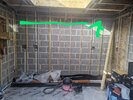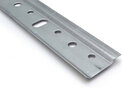- Joined
- 22 Feb 2024
- Messages
- 2
- Reaction score
- 0
- Country

My builder tried to prepare the kitchen walls for the wall units but ended up fixing batterns behind the plasterboard too high, about 30/50mm. I am now thinking If I can get away with installing the units using the supplied brackets just into the plasterboard (decent drywall fixings), use them for the fine adjustments and then install L brackets up to the cross timbers once everything is aligned to take the weights of the units. I am trying to avoid butchering my new walls! The image attached is obviously before boarding and plaster



